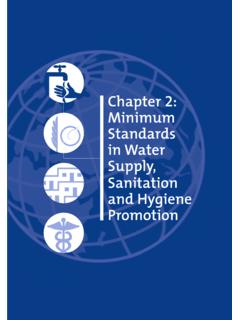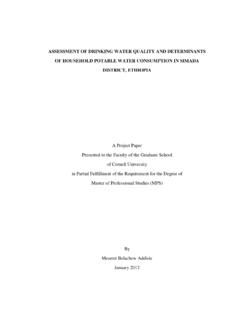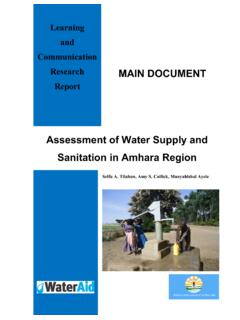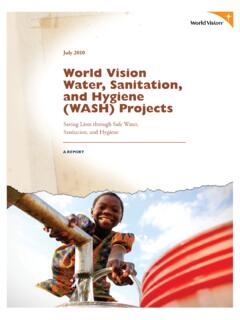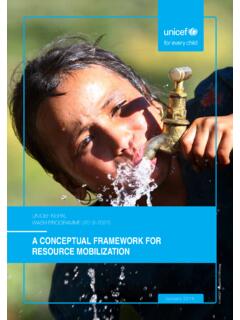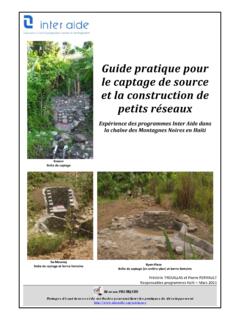Transcription of 11. Control of communicable diseases and prevention of ...
1 Of communicable diseases andprevention of importance of communicable diseases in emergencies and disastersThe five most common causes of death in emergencies and disasters are diarrhoea, acuterespiratory infection, measles, malnutrition and, in endemic zones, malaria. All exceptmalnutrition are communicable diseases directly related to environmental health con-ditions, and even malnutrition is greatly exacerbated by communicable people are particularly vulnerable to communicable diseases whenthe disaster and its immediate consequences reduce resistance to disease because of mal-nutrition, stress, fatigue, etc. and when post-disaster living conditions are Control of communicable diseases depends on a healthy environment (cleanwater, adequate sanitation , vector Control , shelter), immunization, and health workerstrained in early diagnosis and treatment.
2 Thanks to effective environmental health measures, epidemics following disasters are no longer common. Exceptions are the epi-demics occurring in chronic emergencies triggered by drought and civil strife, such asthose that occurred in Africa in the 1980s and 1990s, and the epidemics of communi-cable diseases that have swept refugee camps in Africa and other parts of the world. Func-tioning disease surveillance systems and intact environmental health services are crucialin protecting public health and in responding to these outbreaks when they occur intimes of conditions leading to an epidemic are caused mostly by secondary effects andnot by the primary hazard, except in the case of flooding, which can cause an increasein waterborne and vector-borne diseases (see Box ).
3 Other hazards may leave stand-ing water or pollute, or interrupt drinking- water supplies. High winds, coastal storms,mud slides and even earthquakes can all result in standing water , especially where a cascade of physical effects occurs. For instance, in the Andes it is not uncommon fora volcanic eruption to melt ice and snow, creating floods, mud flows and rock falls. Earth-quakes can trigger landslides that block rivers, causing flooding. In all these cases, excessstanding water can promote the breeding of insect disease vectors, or contaminate watersupplies with waste or natural disasters and armed conflict may result in the breakage of water mainsor the interruption of electricity supplies required to pump water . Sewer pipes andsewage treatment works may also be broken or rendered waterborne and vector-borne disease, there may also be major epidemics ofhighly contagious diseases those spread by personal contact.
4 These are most commonlythe result of crowding survivors living in crowded temporary accommodation withoutadequate ventilation or adequate facilities for personal hygiene and length of time that people spend in temporary settlements is an important deter-minant of the risk of disease transmission. The prolonged mass settlement of refugeesin temporary shelters with only minimal provision for essential personal hygiene is typicalof a situation that may cause epidemic outbreaks of infectious diseases (see Box ).Camps established to provide food relief during famine are a special case, as largenumbers of people who are already weak and possibly ill are likely to remain in suchcamps for a long comprehensive overview of the public health consequences of various forms of dis-asters may be found in Noji (1997).
5 Table presents an overview of the disease prob-lems most often encountered following disasters. Such problems are more likely to occurwhere predisaster conditions, such as those in many densely populated mega-cities, areunsanitary. Steps taken in advance to reduce poverty, increase the level of awareness andorganization, and extend normal health and sanitary services will provide additional pro-tection for the community if disaster for controlling communicable diseases and and preventionPreparedness measures taken before a disaster can greatly increase the ability to controlcommunicable diseases and prevent epidemics. Such measures include: training healthand outreach staff in the identification and management of specific diseases considered11: Control OF communicable diseases AND prevention OF EPIDEMICS169 Box in the Czech Republic1 Eastern areas of the Czech Republic were severely flooded in the summer of 1997.
6 A total of438 towns and villages were affected, and 2151 homes were destroyed. More than 200 000people were left without electricity and 30 000 without gas. About 3500 wells and other watersources were contaminated and wastewater-treatment plants were rendered inoperable. TheCentre of Microbiology of the Czech National Institute of Public Health took immediate action,in collaboration with the regional hygiene stations. All reports of outbreaks of typhoid fever, sal-monellosis, shigellosis, acute diarrhoea, viral hepatitis A, tularaemia, invasive meningococcaldisease, toxoplasmosis, leptospirosis and Lyme disease were evaluated, and a special hepati-tis A vaccination programme was launched among 3 15-year-olds in selected areas. Postdis-aster analysis showed that leptospirosis had increased threefold, but that there had been nodemonstrable flooding effects in the other diseases targeted.
7 No viral hepatitis A was reportedfrom the populations vaccinated. Recommended follow-up measures included monitoring andcontrolling : B. Kriz, unpublished data, mortality among refugees in eastern Zaire1,2 During the emergency phase of a relief operation, death rates should be expressed asdeaths/10 000 per day to allow for the detection of sudden changes. In general, health workersshould be concerned when crude mortality rates (CMRs) in a displaced population exceed 1/10000 per day, or when under-five mortality rates exceed 2/10 000 per eastern Zaire in July 1994, the CMR among one million Rwandan refugees ranged to 000 per day, among the highest ever recorded. Between 6 and 10% of therefugee population died during the month after arrival in Zaire.
8 This high mortality rate wasalmost entirely due to an epidemic of diarrhoeal diseases and inadequate water the third week of the refugee influx, relief efforts began to have a significant measures, such as measles immunization, vitamin A supplements, standard disease-treatment protocols and community outreach programmes, were established in each camp,and the water -distribution system began to provide an average of 5 10 litres per person : International Federation of Red Cross and Red Crescent Societies (1997b).2 Now the Democratic Republic of the CongoENVIRONMENTAL HEALTH IN EMERGENCIES AND DISASTERS170 Table affecting displaced populations in disastersEnvironmental riskDiseaseSymptomsfactorsHealth hazardsAcute upperAll symptoms of the common cold,Crowding, poor hygieneInfluenza and pneumonia mayrespiratory tractfever and heavy coughing.
9 Chest paincause severe complications,infectionsand pain between shoulder blades inespecially in groups at stools at least three times aContaminated drinking-Dehydration, especially in day, with or without blood or or food, or poorchildren, shown by dark May be accompanied by fever, sanitationcolouration of urine, dry nausea or or leathery skinMeaslesA disease of early childhood,Crowding, poor hygieneSevere constitutional characterized by fever and catarrhalsymptoms, high case fatalitysymptoms, followed by maculopapularraterash in the muscles and joints, high feverBreeding ofAnophelesDisease may rapidly becomewith chills, headache, possiblymosquitoes in stagnantfatal, unless medical care isdiarrhoea and bodiesprovided within the first 48 hoursMeningococcalInfected persons may show noCrowdingOften fatal if untreated at an meningitissymptoms for a considerable stage.
10 NeurologicalWhen an epidemic is in progress,problems in survivorsheadache, fever and general malaise will suggest the diagnosis, which mustbe confirmed by lumbar with blood in the stools,Contaminated drinking-Case fatality rate may bedysenteryfever, vomiting and abdominal or food, or poorhighsanitation, poor hygieneViral hepatitis ANausea, slight fever, pale-colouredPoor hygieneLong-term disabling effectsstools, dark-coloured urine, jaundicedeye whites and skin after several fever, headache, bodyUnhygienic conditionsMay be fatal to licetreatmentinfestationsTyphoid feverStarts off like malaria, sometimes withAs for diarrhoeaWithout appropriate medicaldiarrhoea, prolonged fever,care, may lead to fatal occasionally with in a few weeksCholeraModest fever, severe, but liquidAs for diarrhoeaAs for diarrhoeadiarrhoea (rice water stools), abdominal spasms, vomiting, rapid weight loss and andHigh fever, headaches, pain in Breeding of AedesDengue usually runs a milddenguemuscles and joints, red spots on in naturalcourse.










